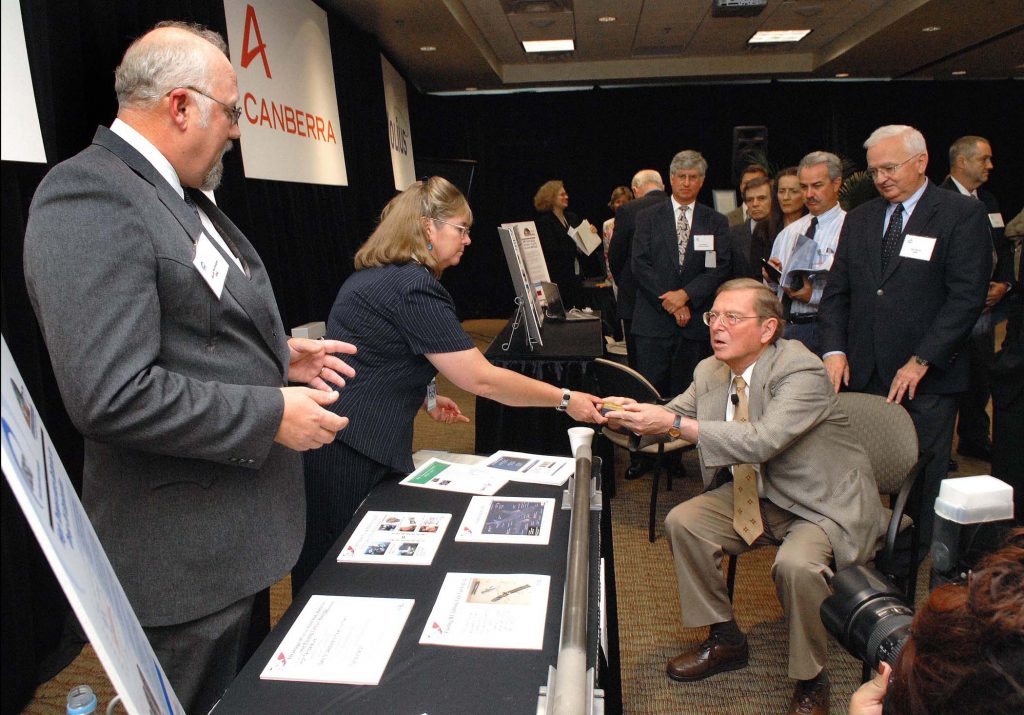
Download 300dpi JPEG image, “domenici-R&D 100.jpg,” 412K (Media are welcome to download/publish this image with related news stories.)
ALBUQUERQUE, N.M. — Researchers at Sandia National Laboratories and their collaborators have won two R&D 100 awards, which are presented by R&D Magazine in recognition of the 100 most technologically significant products introduced into the marketplace over the past year.
Sandia winners include:
- Compute Process Allocator, a computer algorithm technology that increases processing efficiency on massively parallel supercomputers. Developed in conjunction with colleagues at the State University of New York and the University of Illinois. The CPA was licensed to Cray Inc. in 2005.
- HTSS10V, a solid-state, fluoride-based battery that is safer than traditional batteries in high-temperature applications such as oil, gas, and geothermal drilling. HTSS10V was developed in conjunction with the High Power Battery Systems Company in Nizhny Novgorod Russia and General Atomics.
“I congratulate the researchers who have won these awards, which highlight the power and promise of DOE’s investments in science and technology,” Secretary of Energy Samuel W. Bodman said. “Through the efforts of dedicated and innovative scientists and engineers at our national laboratories, DOE is helping to enhance our nation’s energy, economic and national security.”
Sandia is a National Nuclear Security Administration laboratory.
Compute Process Allocator (CPA)
The CPA’s principal application is to maximize throughput on massively parallel supercomputers by managing how processors are assigned to particular computing jobs, given a stream of computing jobs submitted to a job queue. The CPA assigns each job to a set of processors, which are exclusively dedicated to the job until completion. The CPA obtains maximum throughput by choosing processors for a job that are physically near each other, minimizing communication and bandwidth inefficiencies.
In experiments at Sandia, the optimized node allocation strategy employed by CPA increased throughput by 23 percent, in effect, processing five jobs in the time it normally took to process four.
The CPA is scalable to tens of thousands of processors and is currently being used on supercomputers at Sandia (Red Storm), Oak Ridge National Laboratory, Engineer Research and Development Center Major Shared Resource Center, Pittsburgh Supercomputing Center, and the Swiss Scientific Computing Center.
HTSS10V
Solid-state fluoride ion batteries have nearly the same energy density of lithium sulfuryl batteries while being inherently safe. The battery consists of nontoxic fluoride, and all three battery components of the HTSS10V — anode, cathode, and ionic conductor — are solid, making it the best and safest choice for high-temperature activities such as oil and gas drilling, currently its primary application. Traditional lithium batteries are at risk of exploding or leaking chemicals under high-temperature uses. Solid-state battery technology offers the largest temperature range — room temperature to 500 degrees Celsius — of any battery technology.
Other advantages of solid-state batteries include:
- The ability to be flown on commercial aircraft, while lithium sulfuryl chloride batteries can only be transported by ground and must be stored in explosive containers when on a drill rig.
- Longer shelf life and greater reliability in emergency situations, giving them advantages for battery backup or life support systems during a fire or other emergencies.
Researchers are currently working on a rechargeable version for laptop computers.
Limited production of the batteries began in 2005 at Russia’s VNIIEF Institute. Under a joint program with Sandia and General Atomics, the batteries will be produced in Sarov, Russia, and in San Diego, Calif., for high-end oil and gas drilling uses.